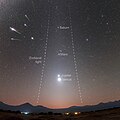File:Meteor shower in the Chilean Desert (annotated and cropped).jpg
页面内容不支持其他语言。
外观

本预览的尺寸:600 × 600像素。 其他分辨率:240 × 240像素 | 480 × 480像素 | 768 × 768像素 | 1,024 × 1,024像素 | 2,048 × 2,048像素 | 7,500 × 7,500像素。
原始文件 (7,500 × 7,500像素,文件大小:9.78 MB,MIME类型:image/jpeg)
摘要
| 描述Meteor shower in the Chilean Desert (annotated and cropped).jpg |
English: The Eta Aquariids meteor shower, which peaked in early May this year, was captured in this stunning image by astrophotographer Petr Horálek. It was taken near San Pedro de Atacama, a Chilean town about 50 km away from the Chajnantor observatory site, where APEX and ALMA, astronomical facilities co-owned by ESO, are located. The Eta Aquariids meteors are caused by leftover debris from Halley’s comet and make up the bright, arrow-like darts of light in the photo. But don’t stop there: this image is literally full to the brim of astronomical phenomena. The luminous object towards the bottom of the sky is Venus. Above it, arranged in a satisfying line, are several planets in conjunction. Directly above Venus is Jupiter, followed by the bright red Mars, and then Saturn. Conjunctions such as this are rare, often occurring decades apart. The planets also trace the zodiacal light, the faint glow stretching like a pillar, up towards the bright stellar-dense centre of the Milky Way, our home galaxy. Zodiacal light is often seen from dark sites like ESO observatories just after sunset, or before sunrise, and is the reflected sunlight from dust particles in the plane of the Solar System. The dust comes from asteroids, passing comets, and even from other inner Solar System planets, such as Mars. Here we see the zodiacal light paired with the red sunset over the mountains and volcanoes surrounding the Chajnantor site, a spectacular backdrop to this dreamy night sky. Link Non-annotated version of this image |
| 日期 | |
| 来源 | [1], File:Meteor shower in the Chilean Desert (annotated) (potw2227b).jpg, |
| 作者 | ESO/P. Horalek |
许可协议
 |
This media was created by the European Southern Observatory (ESO).
Their website states: "Unless specifically noted, the images, videos, and music distributed on the public ESO website, along with the texts of press releases, announcements, pictures of the week, blog posts and captions, are licensed under a Creative Commons Attribution 4.0 International License, and may on a non-exclusive basis be reproduced without fee provided the credit is clear and visible." To the uploader: You must provide a link (URL) to the original file and the authorship information if available. |
说明
添加一行文字以描述该文件所表现的内容
此文件中描述的项目
描繪內容
10,000
image/jpeg
文件历史
点击某个日期/时间查看对应时刻的文件。
| 日期/时间 | 缩略图 | 大小 | 用户 | 备注 | |
|---|---|---|---|---|---|
| 当前 | 2024年5月1日 (三) 06:56 |  | 7,500 × 7,500(9.78 MB) | CactiStaccingCrane | Uploaded a work by ESO/P. Horalek from [https://www.eso.org/public/images/potw2227b], File:Meteor shower in the Chilean Desert (annotated) (potw2227b).jpg, with UploadWizard |
文件用途
以下页面使用本文件:
全域文件用途
以下其他wiki使用此文件:
- en.wikipedia.org上的用途
- es.wikipedia.org上的用途
元数据
此文件中包含有扩展的信息。这些信息可能是由数码相机或扫描仪在创建或数字化过程中所添加。
如果此文件的源文件已经被修改,一些信息在修改后的文件中将不能完全反映出来。
| 感光度(ISO) | 10,000 |
|---|---|
| 数据生成日期时间 | 2022年7月4日 (一) 09:00 |
| 提供者 | ESO/P. Horalek |
| 来源 | European Southern Observatory |
| 简短标题 |
|
| 图像标题 |
|
| 使用条款 |
|
| 方向 | 正常 |
| 水平分辨率 | 300 dpi |
| 垂直分辨率 | 300 dpi |
| 使用软件 | Adobe Photoshop CC 2019 (Windows) |
| 文件修改日期时间 | 2022年6月27日 (一) 17:28 |
| YCbCr位置 | 中间 |
| Exif版本 | 2.21 |
| 数字化日期时间 | 2022年5月3日 (二) 11:15 |
| 每个色彩组分意义 |
|
| 支持的Flashpix版本 | 1 |
| 色彩空间 | sRGB |
| 场景拍摄类型 | 标准 |
| 关键词 |
|
| 联系信息 |
Karl-Schwarzschild-Strasse 2 Garching bei München, None, D-85748 Germany |
| IIM版本 | 2 |
